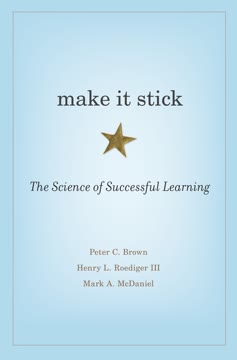つの重要なポイント
1. 学習は誤解されている:効果的な戦略はしばしば直感に反する
私たちが学び、記憶する方法に関する実証的な研究は、学習方法についての常識が実際にはほとんど無駄な努力であることを示している。
一般的な誤解。 多くの人々は、教材を再読したり、試験前に詰め込み学習をしたり、一度に一つのトピックに集中することが効果的な学習戦略であると信じている。しかし、研究によれば、これらの方法は長期的な記憶保持や理解にはあまり効果的ではないことが示されている。
直感に反する戦略。 最も効果的な学習技術はしばしば直感に反するものである:
- 取り出し練習(自己テスト)
- 間隔を空けた復習
- 異なるトピックの交互学習
- 望ましい困難の導入
証拠に基づく技術の利点。 これらの戦略は以下の効果をもたらす:
- 深い理解
- 長期的な記憶保持の向上
- 新しい文脈での知識の応用能力の向上
- 問題解決能力の強化
2. 取り出し練習は再読よりも記憶を強化する
繰り返し努力して情報を取り出すことや練習することは、学習を一連の関連するアイデアや運動スキルのシーケンスに統合し、後の状況で適応して応用できる意味のある全体に融合させるのに役立つ。
テスト効果。 自己クイズや練習テストを通じて情報を積極的に取り出すことは、受動的な再読よりも記憶を強化する。この現象は「テスト効果」または「取り出し練習効果」として知られている。
その仕組み:
- 取り出しは神経経路を強化する
- 知識のギャップを特定する
- 長期的な記憶保持を改善する
- 新しい文脈で情報を応用する能力を向上させる
実践的な応用:
- フラッシュカードを使用する
- 練習テストを受ける
- 他人に概念を説明する
- 記憶から要約を書く
3. 間隔を空けた練習と交互学習は長期的な記憶保持を向上させる
練習条件が変化したり、他の教材の練習と交互に取り出しが行われると、識別と帰納の能力が向上し、後の新しい状況で学習を応用する多様性が増す。
間隔効果。 練習セッションを時間をかけて分散させることは、詰め込み学習(集中学習)よりも長期的な記憶保持を向上させる。これにより、統合の時間が確保され、記憶痕跡が強化される。
交互学習。 練習セッション中に異なるトピックや問題の種類を混ぜることは、以下の点で改善をもたらす:
- 概念間の識別能力
- 新しい状況への知識の転移
- アイデア間の関係の全体的な理解
例:
- 異なる種類の数学問題を交互に解く
- 様々なスポーツスキルを混ぜて練習する
- 一つのセッションで関連するが異なる歴史的時代を学ぶ
4. 困難を受け入れる:努力を要する学習は脳を変える
より大きな認知努力を伴う困難を克服することは、学習の深さと持続性において大いに報われる。
望ましい困難。 学習中に挑戦を導入することは、より強力で持続的な記憶と深い理解をもたらす。これらの困難はより多くの努力を要するが、長期的な成果を向上させる。
望ましい困難の種類:
- 生成(解決策を教えられる前に問題を解決しようとする)
- 反省(学んだ教材を分析し、詳述する)
- 校正(知識の判断を客観的なフィードバックと一致させる)
神経可塑性。 努力を要する学習は脳に物理的な変化をもたらし、新しい神経接続を作り、既存のものを強化する。このプロセスは、時間とともに認知能力と問題解決能力を向上させる。
5. 知識の錯覚を避ける:真の理解を測るために自己テストを行う
テキストの流暢さには二つの欠点がある:それは学んだことの誤解を招く指標であり、教材を覚えているという誤った印象を与える。
メタ認知。 自分が知っていることと知らないことを正確に評価することは、効果的な学習にとって重要である。多くの人々は知識の錯覚により自分の理解を過大評価する。
一般的な錯覚:
- 教材への親しみを習熟と誤解する
- 処理の容易さを深い理解と混同する
- 後知恵バイアス(「最初から知っていた」と感じる)
錯覚に対抗する戦略:
- 定期的な自己テスト
- 客観的なフィードバックを求める
- 他人に概念を説明する
- 新しい文脈で知識を応用する
6. 学習スタイルを超えて:効果的な学習戦略に焦点を当てる
教育方法がその好みに合った場合に学習が向上するという説得力のある証拠はない。しかし、学習方法に関する他の種類の違いは重要である。
学習スタイルの神話。 人気があるにもかかわらず、好みの学習スタイル(例:視覚、聴覚、運動感覚)に合わせた指導が学習成果を向上させるという科学的証拠はほとんどない。
より重要なこと:
- 証拠に基づく学習戦略の使用
- メタ認知スキルの開発
- アイデア間のメンタルモデルと接続の構築
- 知識の取り出しと応用の練習
代替アプローチ:
- すべての学習者に効果的な学習戦略に焦点を当てる
- 個々の好みではなく、内容に応じた教育方法を適応させる
- 学習者が多様な学習スキルを開発するよう奨励する
7. 意図的な練習と成長マインドセットで能力を向上させる
どの分野でも、専門的なパフォーマンスは、ますます複雑なパターンのゆっくりとした習得を通じて得られると考えられている。これらのパターンは、さまざまな状況でどの行動を取るべきかについての知識を蓄えるために使用される。
意図的な練習。 専門知識を達成するには、特定のパフォーマンスの側面を改善することを目的とした集中した努力が必要である。これには以下が含まれる:
- 明確な目標の設定
- 即時のフィードバックの取得
- 快適ゾーンを超えることの継続
成長マインドセット。 努力と練習を通じて能力が発展するという信念は、より大きな回復力と成果をもたらす。これは、能力を生まれつきのものと見なす固定マインドセットとは対照的である。
専門知識の開発:
- 複雑なスキルを構成要素に分解する
- 難易度と複雑さを増しながら練習する
- フィードバックを求め、それに応じて調整する
- 挑戦を受け入れ、失敗から学ぶ
8. 定着させる:さまざまな設定で証明された学習技術を応用する
本書で紹介されている非常に効果的な学習技術は、学習者、教師、トレーナーが活動しているあらゆる場所で今すぐに活用できる。
教室での応用:
- 頻繁な低リスクのクイズを取り入れる
- 過去の教材を強化するための累積テストを使用する
- 学生に説明を生成させる
- 間隔を空けた練習と交互学習の機会を提供する
職場でのトレーニング:
- シミュレーションベースの学習を実施する
- シナリオベースの評価を使用する
- 反省とピアティーチングを奨励する
- 間隔を空けた復習を取り入れたトレーニングプログラムを設計する
自己主導の学習:
- 自己クイズの習慣をつける
- 間隔を空けた復習スケジュールを作成する
- 挑戦と知識の新しい応用を求める
- 学習経験を定期的に反省し、戦略を調整する
これらの証拠に基づく技術をさまざまな学習環境で応用することで、個人や組織は学習成果の効果と持続性を大幅に向上させることができる。
最終更新日:
FAQ
What's Make It Stick: The Science of Successful Learning about?
- Focus on Learning Science: The book delves into the science of learning and memory, offering evidence-based strategies for effective learning.
- Counterintuitive Strategies: It presents strategies that may seem counterintuitive, like embracing difficulties and using retrieval practice, which lead to deeper learning.
- Real-Life Examples: Through stories and examples, the authors illustrate successful application of these principles in various fields.
Why should I read Make It Stick: The Science of Successful Learning?
- Improve Learning Effectiveness: The book helps you adopt effective learning strategies grounded in cognitive science for better retention.
- Debunking Myths: It challenges common beliefs about learning, such as the effectiveness of cramming and learning styles.
- Applicable to All Learners: Whether you're a student, teacher, or lifelong learner, the insights can enhance your learning processes.
What are the key takeaways of Make It Stick: The Science of Successful Learning?
- Effortful Learning is Better: Learning is deeper and more durable when it requires effort, as easy learning often leads to quick forgetting.
- Retrieval Practice is Crucial: Actively recalling information strengthens memory and interrupts forgetting, making testing a powerful tool.
- Spaced and Interleaved Practice: Spacing out practice and mixing topics leads to better retention and understanding.
What are the best quotes from Make It Stick: The Science of Successful Learning and what do they mean?
- "Mastery is a quest": True mastery requires effort and persistence, not just passive learning, encouraging readers to embrace challenges.
- "The harder it is to recall": Struggling with recall strengthens memory, suggesting that difficulties can lead to deeper understanding.
- "Knowledge is not knowhow": This underscores the difference between rote memorization and true understanding, encouraging focus on concepts.
What is retrieval practice, and why is it important in Make It Stick: The Science of Successful Learning?
- Definition of Retrieval Practice: It involves recalling information from memory, strengthening neural pathways associated with that information.
- Benefits of Retrieval: Engaging in retrieval practice reinforces learning and improves long-term retention.
- Practical Applications: Techniques like self-testing and flashcards are effective forms of retrieval practice.
How does spacing out practice improve learning according to Make It Stick: The Science of Successful Learning?
- Concept of Spaced Practice: It involves distributing learning sessions over time rather than cramming all at once.
- Long-Term Retention: Spacing out practice strengthens memory and improves retention over the long term.
- Real-World Examples: Examples like surgical residents performing better with spaced lessons demonstrate its effectiveness.
How does interleaved practice improve learning in Make It Stick: The Science of Successful Learning?
- Definition of Interleaved Practice: It involves mixing different topics or types of problems during study sessions.
- Benefits of Interleaving: This method enhances learning by forcing adaptation and better discrimination between concepts.
- Contrast with Massed Practice: Massed practice leads to quick gains but poor long-term retention, unlike interleaving.
What are "desirable difficulties" in Make It Stick: The Science of Successful Learning and how do they enhance learning?
- Definition of Desirable Difficulties: Challenges that make learning harder but lead to stronger retention and understanding.
- Examples of Desirable Difficulties: Techniques like spacing, interleaving, and retrieval practice create these beneficial challenges.
- Long-Term Benefits: Embracing these difficulties encourages deeper processing and more durable learning outcomes.
How do cognitive biases affect learning and self-assessment in Make It Stick: The Science of Successful Learning?
- Understanding Cognitive Biases: Biases can lead to overconfidence and misjudgments about what we know.
- Illusions of Mastery: Learners often mistake familiarity with material for true understanding, leading to poor self-assessment.
- Importance of Feedback: Seeking feedback and engaging in self-testing can counteract these biases and improve self-awareness.
What role does reflection play in the learning process according to Make It Stick: The Science of Successful Learning?
- Definition of Reflection: Involves reviewing and thinking critically about what has been learned to enhance understanding.
- Benefits of Reflective Practice: Helps connect new knowledge to prior experiences and solidify understanding.
- Practical Techniques: Writing summaries or discussing key concepts with peers can facilitate reflection and deepen learning.
How can I apply the principles from Make It Stick: The Science of Successful Learning in my own learning?
- Implement Retrieval Practice: Use self-testing techniques like flashcards to reinforce learning and improve retention.
- Incorporate Spacing and Interleaving: Space out study sessions and mix different subjects to enhance understanding.
- Embrace Challenges: View difficult material as opportunities for growth and deeper learning.
What is the difference between rule learners and example learners in Make It Stick: The Science of Successful Learning?
- Rule Learners: Focus on understanding underlying principles, better at applying knowledge to new situations.
- Example Learners: Tend to memorize specific examples without grasping broader rules, hindering problem-solving.
- Improving Example Learning: Comparing multiple examples helps identify commonalities and extract underlying rules.
レビュー
本書『Make It Stick』は、効果的な学習のためのエビデンスに基づいた戦略を提供しており、再読のような従来の方法よりも、想起練習、間隔をあけた復習、交互学習を強調している。本書は学習に関する一般的な誤解に挑戦し、学生、教師、生涯学習者のための実践的な技術を提供している。一部の読者は内容が繰り返しであったり、長すぎると感じることもあるが、多くの人々はその洞察と実用性を称賛している。著者たちは、努力を要する学習、困難を受け入れること、成長マインドセットの発展の重要性を強調している。総じて、記憶保持と学習効率の向上に関する貴重なアドバイスが含まれているとして、本書は多くのレビューアーから推薦されている。
Similar Books














